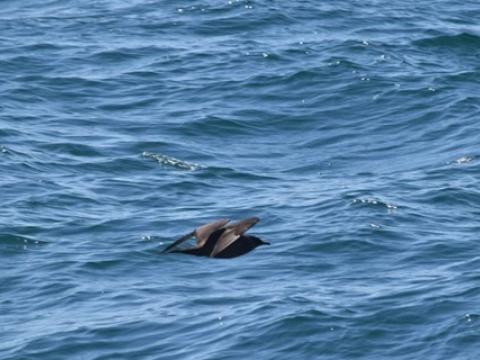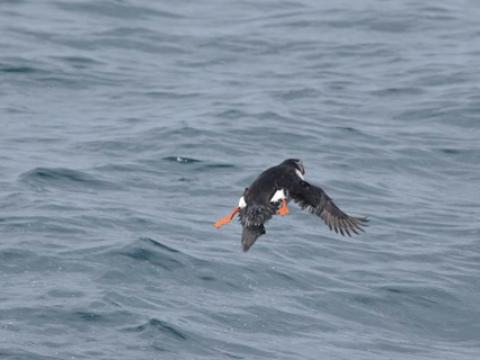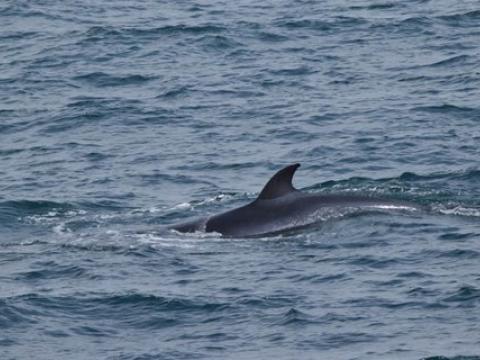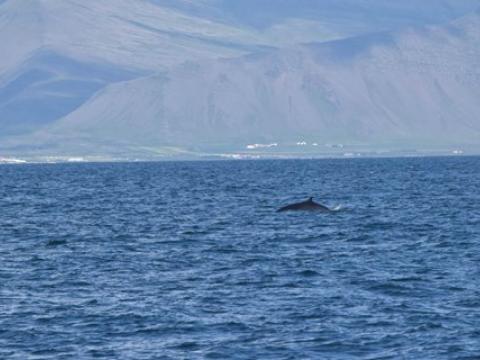Tour at 20:30
Report from Elding: we market the midnight tour as 'Whales in the Midnight Sun' but sometimes the whales are missing and sometimes the midnight sun is. Tonight, however, we had both and on a grand scale at that! We started off after close to an hour of searching in just as good as perfect conditions with 2-3 Minke Whales but then, wondering if some splashes seen towards Hafnarfjall Mountain might be the dolphins we saw today,we went off. Dolphins we did not find but what we did find was a splendid so easy-going Minke Whale that it is hard to describe. For one thing therewere many close approaches, good blows, and last but not least, a stomach roll showing part of the fluke! It was so hard to leave but even on the midnight tour, with no following tours waiting for us, it still has to be done at some point.
- Baldur Thorvaldsson
Tour at 17:00
Report from Hafsúlan: As we sailed out into the evening sun there was still quite a bit of swell and cold wind coming our way. Quite a few of our passengers took advantage of the warm overalls we provide on board and joined our "search party" on the top deck. And we had lots of talented spotters on this tour! But unfortunately the whales were really trying to challenge us tonight... We saw a back here, a blow there, but never got close enough to the animals to get a good look. Eventually we discovered "Humpie", the Minke Whale we had seen previously this day. Unfortunately this time this minke was travelling quite fast and heading further out of the bay. So after a while we stopped following this whale and headed back into the bay a bit further. We got some quite nice looks at another individual, but again would have liked to get a bit closer. All in all we saw at least 2-3 different minkes and enjoyed another calm ride home in the evening sun...
- Linda
Tour at 14:00
Report from Elding: Blue skies and barely any wind accompanied us on our sail out into the Bay of Faxafloí. It took us some time until the first Minke Whale appeared, but the first would be one that followed us until the end of our trip. Promptly the researchers were able to identify the individual as Peanut. Soon after Peanuts appearance another individual joined the show. As both whales were changing course very frequently and the fish finder showed some fish in the area, the assumption that they were feeding was not far fetched. Several times throughout the trip Peanut was surfacing as close as 25 meters from the vessel, showing off its two blowholes. Peanut also pierced though the waves, almost like an arrow. The weather and the nice Minke Whale encounters made this trip special.
-Dominik Schmid
Tour at 13:00
Report from Hafsúlan: Even though the sun greeted us for the first tour of the afternoon, there was also quite a stiff and chilly breeze. We had to search quite a while until we came into an area where there had been some dolphins sighted shortly before. Unfortunately, they seemed to be long gone by the time we got there, so our searching continued. And we did succeed - we found at least 3-4 different Minke Whales over the course of this trip. One of them we quickly identified as "Humpie", an individual we know quite well from previous years. As is often the case Humpie was in quite a friendly mood and came swimming straight up towards the boat at one point. Apart from other nice looks earlier on this gave us a great opportunity to see the whale's blowholes... The ride back was calm and fairly warm - a nice ending to a tour with some good looks at the minkes of Faxaflói!
- Linda
Tour at 10:00
Report from Elding: The sun was shining as we headed out this morning but still the wind managed to cool us down so the red overalls came in handy! We sailed for about an hour before we spotted two pods of 8-10 White-beaked dolphins breaching in the distance. The dolphins moved quite fast and some of them started to swim in circles, which could indicate that they were hunting and trying to concentrate the prey together in a tight group. We were able to watch the dolphins for some time, but because they seemed so busy we decided to search for something else. Very soon after we left the dolphins we spotted a Minke whale, and soon we realized there were around 3-4 minke's in the area, one of them called Peanut which has been commonly seen for the last years. We got a close look at the minke whales as they pierced throught the surface, sometimes very close to the boat. As we headed back to the harbour we saw breaching dolphins in the distance, but as we got closer to that area the dolphins seemed to disappear. It was a very nice tour in the morning sun and obviously there is alot of prey in the bay!- Freydís Ósk
Tour at 09:00
Report from Hafsúlan: this tour was yet another proof of that patience is the name of the game in whale-watching. We sailed out under quite good conditions but for the first hour and a half, no sign of life apart from birds. But then, about an hour and a half into the tour, all broke loose all of a sudden and we saw a White-beaked Dolphin lunging itself out of the water continuosly about 200 meters away from us. It was clearly taking the job of the herder, driving fish towards its mates. Soon it became clear that it was anything but alone, around 10-15 others were in the area and that feeding was ongoing. In two different places we saw these hyberactive dolphins before leaving them to their own thing and checking out a very good Minke Whale that another boat had pointed us to. It surfaced several times close to us, giving us loud blow sounds and very good views of the back, sadlytowards the time when we had to start heading back to Reykjavik but the tour that had started in such a quit manner had all of a sudden turned nothing short of brilliant!
- Baldur Thorvaldsson
Birds seen on todays tour include: Northern gannets, Northern fulmars, Kittiwakes, Arctic terns, Arctic skuas, Common guillemots, Lesser black backed gulls, Atlantic puffins.

